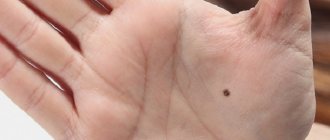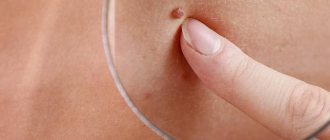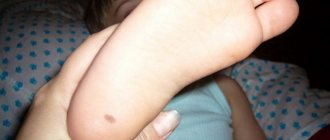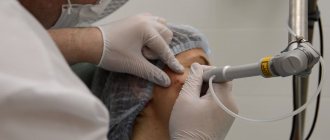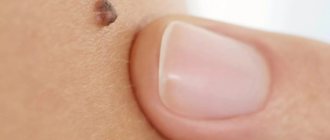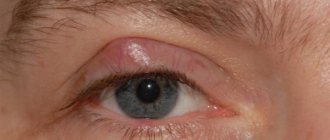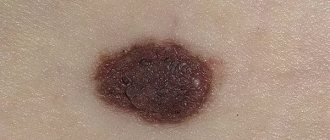If a mole appears on the eyelid, then you need to take a closer look at it, because many probably know that this benign formation on the skin is some kind of sign and carries a certain meaning. Moles, or, as doctors also call them, nevi, can be located anywhere in the eyelid and even involve eyelashes. There are many reasons for the appearance of skin tumors, so it would be a good idea to consult a specialized doctor, because dark spots can be either a consequence of excessive exposure to the sun’s rays or indicate changes in hormonal levels.
A mole on the eyelid is a cause for aesthetic discomfort, but it is also a potential factor in the development of oncology.
Why do they appear?
| № | Cause | Explanation |
| 1 | UV radiation | Benign formations appear on the eyelids as a result of excessive exposure to ultraviolet rays, which, in turn, lead to intensive production of melanin, the pigment of skin cells responsible for the development of new nevi |
| 2 | Hereditary factor | The origin of moles is already embedded in DNA, therefore, if parents have congenital dark spots on the eyelid, then it is more likely that their children will also have them |
| 3 | Viruses | As recent scientific research in the field of medicine has shown, moles on the eyelid appear during regularly performed x-rays, after radiation exposure and during viral infections |
| 4 | Pharmaceutical medicines | Often nevi are localized on the eyelids and eyelashes due to taking certain medications |
| 5 | Hormonal disbalance | The cause of the appearance of benign formations in the upper part of the eye may be the period of pregnancy or hormonal changes at a certain age in adolescents. |
Types of moles on the eyelid
Nevi on the eyelid can vary in shape, structure, size and color.
There are 2 main types of nevi:
- Vascular. They are small, slightly pink or purple spots on the skin that arise due to the accumulation of an excessive number of blood vessels. The reasons for their formation are disturbances in the normal functioning of the venous system.
- Not vascular. They are light brown or black in color and are formed from melanocytes - skin cells responsible for the color of the skin. Their structure does not contain blood vessels and, depending on the depth of the pigment cells, they are divided into: Intradermal - localized in the basal parts of the dermis.
- Epidermal - formed on the surface layer of the skin and are called hanging moles, since its upper part protrudes above the upper border of the epidermis. A hanging mole on the eyelid usually occurs in old age.
- Mixed - localized in the middle layers of the dermis and have the appearance of a flat spot that does not protrude beyond the upper limits of the skin.
About the choroid
Such education is almost invisible. It occupies the posterior region in the fundus, but sometimes occurs on the ocular equator of the right or left eye. Most often, they are identified by the age of ten, since at this age the body begins to undergo hormonal changes. In most cases, the membrane of the fundus is saturated with single choroids and they can rarely be found in a paired arrangement.
Nevi may form on the choroid. They look like flat spots that may protrude above the bottom of the eye. These spots can be enjoyed upon careful examination of the eye, as they have clear feathery contours. According to the color scheme, nevi on the choroid are classified as dark, but sometimes they are transparent.
The following division is characteristic of nevi in the choroid:
Progressive species are characterized by changes in their own size, as a result of which they can gradually move into the category of malignant neoplasms. Stationary spots do not change shape with size, so they are safer.
Progressive types of nevi in the choroid often cause the following sensations:
This type of nevus in the choroid is necessarily treated by oculists and ophthalmologists using:
Self-medication of this pathology is dangerous for the body, as it can negatively affect the quality of vision. By the way, the pupil may also suffer from such actions.
Symptoms of degeneration
Moles are on the skin of every person and, to a greater extent, they do not pose a health hazard, however, you need to be wary if the following changes occur to them:
- An increase in size due to a process occurring in the skin cells that affects the growth of pigment. It could be a cancerous tumor.
- Irritating sensation, itching, tingling, skin tightness in the area of the mole and pain.
- Bleeding, redness and pus formation.
- Discoloration of the entire mole, or partially in the form of spots on its surface.
- Complete disappearance of the nevus.
- A transformation in appearance, characterized by the appearance of cracks, bumps or nodules on the surface of the neoplasm.
If these symptoms appear, you will need to consult a specialist. It is strictly contraindicated to eliminate nevi at home using improvised means, because this, at first glance, harmless benign formation can lead to serious irreversible processes in the body. To remove a mole once and for all, you need to get rid of its roots; this is the only way to prevent its reoccurrence.
First aid
In case of inflammation of the iris and ciliary body of any nature, first aid is aimed at maximizing the dilation of the pupil, which allows solving several problems at once. Firstly, when the pupil dilates, the vessels of the iris contract, therefore, the formation of exudate decreases and at the same time accommodation is paralyzed, the pupil becomes motionless, thereby ensuring rest for the affected organ.
Secondly, the pupil is diverted from the most convex central part of the lens, which prevents the formation of posterior synechiae and makes it possible to rupture existing adhesions. Thirdly, the wide pupil opens the exit into the anterior chamber for exudate accumulated in the posterior chamber, thereby preventing the gluing of the processes of the ciliary body, as well as the spread of exudate into the posterior segment of the eye.
We suggest you familiarize yourself with a cheap analogue of Visine for red eyes
1000, midriacil solution. To enhance the effect, place a narrow strip of cotton wool soaked in mydriatics behind the eyelid. In some cases, you can put a crystal of dry atropine behind the eyelid. Non-steroidal anti-inflammatory drugs in the form of drops (naklof, diclof, indomethacin) enhance the effect of mydriatics.
The next emergency measure is a subconjunctival injection of steroid drugs (0.5 ml of dexamethasone). For purulent inflammation, a broad-spectrum antibiotic is administered under the conjunctiva and intramuscularly. To eliminate pain, analgesics and pterygopalatine-orbital novocaine blockades are prescribed.
How to delete?
If the moles that appear on the eye do not cause discomfort or interfere, then there is no need to take any measures against them. However, a nevus that is localized on an eyelash, in the corner of the eye, or otherwise bothers a person, as well as if various changes occur to it, requires immediate surgical intervention. Removing a mole on the eyelid is a piece of jewelry work that should be performed by a qualified doctor. Specialized doctors offer 5 ways to get rid of unwanted moles:
Remove moles from the eyelid only in extreme cases, because... there is a risk of harming your vision.
- Excision with a high dose of ionizing radiation. It is used mainly for oncological nevi. After the procedure, there are no scars left at the site of tumor removal.
- Surgical intervention. Allows you to completely eliminate the formation, without the possibility of risk of recurrence. Surgical excision is preferred if malignancy is suspected. This method is used to cut out moles on both the lower and upper eyelids. The disadvantage of the operation is noticeable scars at the site of the removed tumor.
- Application of laser. This procedure completely protects against infection, and doctors consider it the best for removing moles from the eyelid. Laser surgery is absolutely painless and does not require large amounts of money, and the entire procedure takes about 5 minutes.
- Excision by destroying the growth with liquid nitrogen at sub-zero temperatures. This method in medicine is called cryodestruction. It is often used for flat nevi, whose borders do not extend beyond the upper layer of the epidermis.
- Getting rid of a mole using electricity. Burning out a benign formation with high-frequency current, after this procedure a barely noticeable scar remains.
Malignant tumors of the eyelids
Cancer of the eyelid is a malignant neoplasm of the eyelid. Usually develops against the background of precancerous skin diseases of the eyelid. The group of cancer lesions of the eyelid with a tendency to distant metastasis includes squamous cell carcinoma and metatypical cancer. Squamous cell tumor of the eyelid in the initial stages is a small focus of mild erythema. Subsequently, a zone of compaction appears in the affected area, turning into an ulcer with dense, indented edges. The tumor can produce both lymphogenous and hematogenous metastases. Metatypic cancer in its histological structure is an intermediate form between squamous cell and basal cell tumors of the eyelids. Prone to rapid growth and early metastasis.
Treatment can be surgical or conservative. Surgical removal or diathermoexcision of the neoplasm with surrounding intact tissue is performed. Close-focus radiotherapy is widely used. Chemotherapy is sometimes used for small eyelid tumors. In advanced cases, orbital exenteration is performed in combination with preoperative radiotherapy. The prognosis is quite favorable, the five-year survival rate is 88%.
Meibomian gland cancer is a rare, high-grade eyelid tumor. Usually located on the upper eyelid. Externally it resembles a basal cell carcinoma. Rapidly progresses and metastasizes. Treatment is radiotherapy. Even with timely and adequate treatment, relapses are detected in 90% of patients within two years after the end of therapy. The five-year survival rate is 35-50%. Death occurs as a result of metastasis.
Melanoma of the eyelid is the most malignant tumor of the eyelids. Rarely diagnosed. Typically, melanoma is localized in the lower eyelid, outer or inner corner of the eye. More often it is a flat spot with uneven, blurry contours, less often - a node with a tendency to bleed. Color ranges from yellowish to almost black. The eyelid tumor is surrounded by a zone of hyperemia and increased pigmentation. Flat neoplasms predominantly grow on the surface, nodular forms quickly penetrate deep into the tissue.
For melanomas smaller than 10 mm, surgical excision is performed using microsurgical techniques. For eyelid tumors larger than 15 mm, radiation therapy is used. The prognosis depends on the thickness of the tumor. For melanomas with a thickness of less than 0.75 mm, the average five-year survival rate is about 100%, for nodules with a thickness of more than 1.5 mm - 50%. The cause of death is distant metastasis.
Source: https://www.krasotaimedicina.ru/diseases/oncologic/eyelid-tumor
How and why nevi appear on the skin
Almost everyone is interested in the appearance of pigmented spots on their skin, what is it and why are they necessary? This is especially concerning for those who have nevi that appear in very inconvenient places, for example, when a mole appears on the eyelid, which greatly interferes with simple life, not to mention hygiene and makeup. There is no need for the skin to have nevi, but they appear nonetheless. Their appearance is explained by improper formation of skin cells:
- in congenital birthmarks, nevi are malformations of the skin,
- with acquired nevi, the formations are benign tumors.
In any case, birthmarks have their own shape and color. The shape of the pigmented spot should be smooth and symmetrical, but the color of the nevus depends on its type and pigment, due to which the spot is formed on the skin. Stand out:
- vascular nevi, predominantly red or pink;
- Not vascular nevi, their color can vary from dark and even black to light brown or flesh-colored.
If you have a mole on your left eyelid, then most likely it is not a vascular formation, although only a specialist can give you an accurate answer. At the same time, the nevus does not necessarily have to appear on the other eyelid, because it is not a contagious skin defect.
It is much more difficult for patients to answer another question – about why a person needs moles. Due to pigment, nevi appear in skin cells, which can degenerate into melanomas. However, if an inflammatory process begins in the body, then it is through nevi that this can be noticed and stopped as early as possible. You just need to not miss this moment and contact a dermatologist or oncologist in time to examine your skin.
Risk of malignancy (malignancy) of nevi.
The very presence of nevi in a person creates some risk of developing skin melanoma, a malignant tumor that develops from melanocytes. People with multiple small nevi have a higher than average risk. The risk factor is not only the number of nevi on the skin, but also the presence of their forms protruding above the surface. The occurrence of skin melanoma is possible after a nevus injury: single (bruises, abrasions, cuts) or chronic (permanent trauma by clothing or shoes).
Since in 50% of cases skin melanoma develops against the background of previous nevi, they are considered as a precancerous disease. There is a direct relationship between the size of nevi and the frequency of their malignancy.
In terms of malignancy, there are two most dangerous types of nevi: dysplastic and congenital. Under certain conditions, dysplastic nevi can degenerate into melanoma in 100% of cases. Any of the congenital nevi can also develop melanoma.
The risk of malignancy of a nevus with a diameter of more than 2 cm is 5-20%, and nevi located on the face are especially dangerous. In a person with 20 nevi, the risk of developing melanoma increases 3 times.
The main external differences between melanoma (4 photos on the left) and nevi (4 photos on the right), from top to bottom: asymmetry, uneven contours (ragged, jagged border), uneven pigmentation (coloring in various shades of black and brown), changes in the diameter of the element.
What changes and why can happen to a nevus?
Pigmented spots on the body can appear at any time:
- immediately after birth (congenital nevi),
- in childhood at 1-2 years (acquired),
- in adolescence,
- during pregnancy.
The last two periods of time are associated with hormonal imbalances. At the same time, you may notice that a mole has disappeared, begun to grow or change. However, this will not lead to anything good, so it is necessary to pay special attention to new growths on the skin at such moments. Ultraviolet irradiation, hormonal treatment and hereditary factors can also affect changes in nevi.
Here are some changes in the nevus that should alert you:
- growth in size. Think for yourself why the mole is growing - it is not related to your growth, if the nevus is acquired, a process is probably taking place in the skin cells that affects the spread of pigment, and this could be a malignant tumor;
- soreness and discomfort. This includes all kinds of burning, tingling, itching or dryness in the area of the nevus;
- redness, bleeding and suppuration. There is no point in staring - the inflammation is immediately visible, otherwise it is impossible to explain such changes in the nevus. So you need to urgently consult a dermatologist;
- the color changes. In this case, the full color of the nevus may change, or partially, when specks of a different color appear on the surface of the birthmark;
- halo and disappearance. Sometimes a nevus may disappear, but this is not always safe, so as soon as you notice a halo around a mole, immediately consult a doctor to examine the birthmark;
- oddities in appearance. This is the asymmetry of the nevus, the appearance of cracks, bumps and nodules on its surface.
When the nevus changes, it should be removed, but carefully and not by a cosmetologist or on your own, only by a doctor! Remember that the mole under the skin has “roots” that must be removed along with the upper layers of the nevus. If every “root” is removed, then you can be sure that there will be no recurrence of the pigment spot at the site of the removed one. In the same case, if the removal is not completed completely, a new nevus may not only appear, but also degenerate into a malignant tumor. So even when choosing a specialist to remove a mole, you need to be careful and contact only the best, such as Elena Vladimirovna Salyamkina.
Treatment tactics, indications for surgical removal of nevi.
In most cases, acquired nevi do not require any treatment, but there are indications for their surgical removal:
1. Cosmetic indications (at the patient’s request, remove a disfiguring nevus).
2. The location of a common nevus in places difficult for self-control (for example, on the scalp, perineum).
3. Identification of such signs of atypia in the nevus as uneven distribution of melanin, jaggedness of its borders, their vagueness, and a relatively large diameter (more than 5 mm).
4. Atypical development of the nevus, including a sudden change in shape and size.
5. Nevi with a high risk of malignancy (for example, giant congenital nevus; dysplastic nevi). All small congenital nevi that have an unusual appearance (uneven coloring, irregular outline, etc.) must be surgically removed before the patient reaches the age of 12 years. Surgery to remove a giant congenital nevus is performed as early as possible.
6. For preventive purposes, in some cases it is advisable to remove nevi if there are a significant number of them, as this prevents the possibility of melanoma.
7. Intensely colored nevi of a peripheral location in the extremities, on the mucous membrane, in the subungual area and conjunctiva: they should be removed, since the possibility of dysplastic nevi of such localization raises suspicion regarding their degeneration into melanoma.
8. Frequent repeated irritation and injury to a nevus, for example, located under a belt, bra or collar.
The indications for immediate excision of the nevus are also clearly defined. These are signs of a sudden change over the last month or several:
1. Increase in the area and height of the nevus.
2. An increase in the intensity of pigmentation, especially in cases where it is uneven.
3. The appearance of a corolla of pigment around the nevus, the appearance of satellite elements.
4. Inflammatory process in the nevus.
5. Appearance of itching.
6. Formation of erosions and bleeding.
How can you remove a nevus on the eyelid?
Removing moles on the eyelid is a very delicate job, you cannot miss or make a mistake. Therefore, it is important to discuss in advance with the surgeon which method of removing a nevus from this area is the most suitable and safe. Of course, you can choose any of 5 options:
- Surgical excision
- Cryodestruction,
- Laser surgery,
- Radiosurgery,
- Electrocoagulation.
However, in some cases these methods are less effective. It is not always possible to remove a pigmented spot using any of the methods available in medical practice. In addition, there are some restrictions that your doctor will tell you about. It is worth noting that only a doctor can be trusted to remove a mole from any part of the body!
IMPORTANT! You cannot remove a nevus at home using traditional medicine; this can cause the nevus to degenerate. It is also contraindicated to get rid of nevi from cosmetologists, who may not remove the nevus completely, cause infection and cause melanoma.
If you had a mole on the back of your head, then you could at least choose electrocoagulation in the fight against a nevus, which interferes and causes inconvenience. But when a nevus on the eyelid, it must be removed very carefully, and only 2 treatment options will do. If the birthmark is flat and small, then there is no point in removing it, then most often they are convex and large, so they even interfere with washing, not to mention cosmetic discomfort.
- Laser surgery. Ideal for removing nevus from the skin of the eyelid. Not only does the operation not take more than 5 minutes, but it is also painless and inexpensive, although much depends on the size of the nevus - the larger it is, the more expensive the operation will be.
- Surgical excision. Suitable for any nevus removal. It is more often used to get rid of large spots, malignant tumors, with low financial support, etc. If a mole burns, then you will be suspected of melanoma, and it will be recommended to remove it surgically. You should not be afraid of pain during such an operation, because... You will be given local anesthesia and you will not feel anything. The advantage of this method is its low cost, along with other methods of treating nevi.
Prevention of malignancy of nevi
Prevention of melanoma in patients with nevi consists of early and active detection of pre-melanoma forms (primarily dysplastic nevus). It is necessary to identify patients with the presence of these forms as a “risk group” and carry out constant dynamic monitoring of changes in these elements, or remove them.
Patients with dysplastic nevi should be aware of the signs of degeneration of these nevi into melanoma and thus independently regularly monitor the nature of their changes. These patients are advised to avoid exposure to the sun and use sunscreen when going outside.
Surgeon M.E. Kletkin
Source: https://www.medicalj.ru/diseases/dermatology/950-nevus
Designation of nevi on the eyelid
Nevi on the eyelid are very rare. For this reason, owners of such birthmarks and bumps want to know what nature has given them. According to the theory of meanings, the location of birthmarks on the human body, nevi on the body mean:
- a mole on the right eyelid speaks of the instability of a person who, in a dangerous situation, panics and cannot come to his senses on his own, requiring support and understanding from the outside. Recommendations for such people: be more energetic, kind and easy-going, communicate more often with optimists;
- a nevus on the left eyelid reveals an emotional person, but in a slightly different sense. Such people perceive love, fall in love easily and dream a lot, but can dramatically change their minds even daily. Recommendations: try to think more carefully about your actions and desires so as not to change your decisions, think more, rely less on feelings;
- a spot on the upper eyelid often speaks of happiness in life, of good luck that awaits you along the way;
- a mark on a woman’s lower eyelid speaks of betrayal on the part of the woman herself; they often leave their husbands and become “walkers.” Advice: be wiser, try not to give in to temptations.
- a mole on a man’s lower eyelid speaks of a hermit who can easily leave home and family, easily move, and has no attachments left. Advice: try to settle down, and not only become a beloved husband and father, but also fall in love and become attached to your loved ones on your own;
- a nevus between the upper and lower eyelids (in the inner corner) indicates a penchant for politics, social life, good and useful connections.
Moles near the eyes and on the eyelids can cause discomfort and concern. If the mole is convex or hanging, then rubbing your eyes can accidentally damage it. Particular care must be taken when handling nevus when applying and removing makeup from the eyelids and eyelashes. In most cases, it is easiest to remove such a tumor. We’ll look at how the removal works and whether all methods are suitable in our article.
Benign eyelid tumors
Characterized by slow progression, lack of infiltrating growth and the ability to distant metastasis. Usually the course is favorable; the reason for visiting a doctor is a cosmetic defect. More than 60% of the total number of eyelid tumors are of epithelial origin (papilloma, senile wart), about 25% come from soft tissues (lipoma, fibroma), 12% belong to the category of pigmented neoplasms (benign nevus).
Papilloma (papillary and flat acanthoepithelioma) of the eyelid is a node connected to the eyelid by a thin stalk or a wide base. Can be single or multiple. Usually located on the edge of the eyelid. In appearance, eyelid papilloma may resemble a raspberry or a cauliflower inflorescence. A long-term asymptomatic course is typical. In some cases it can become malignant. Sometimes a tumor of the eyelid, even in the absence of signs of malignancy, spreads beyond the skin to the lacrimal ducts, the mucous membrane of the eyelid and even the paranasal sinuses.
Senile wart (seborrheic keratosis, basal cell papilloma) is a tumor of the eyelids, similar in appearance to papillomatous nevus. It is an exophytic growing node of brown, grayish or yellowish color. Usually located on the lower eyelid. Painless, dense to the touch. May be oily or dry. A tumor of the eyelid develops over many years and usually does not show a tendency to malignancy. A more intense keratinization is observed compared to papilloma.
Keratoacanthoma is a dense tumor of the eyelids with a diameter of 1-3 cm with a depression in the center. Along with the eyelids, it can affect the ears, cheek area and bridge of the nose. Provoking factors include injuries, viral infections and prolonged contact with certain toxic substances. Prone to self-healing with the formation of a deforming retracted scar. The duration of the disease is 9-12 weeks. During the first 3-5 weeks, the eyelid tumor grows, then the stage of ulceration and healing begins. Usually does not recur.
Trichoepithelioma is a tumor of the eyelids arising from hair follicles. Usually develops in childhood or adolescence. It is a dense nodule measuring 1-3 mm. In some cases, it can grow up to 1 cm. It can be single or multiple, often more than 10 eyelid tumors are detected in one patient. It can become malignant, transforming into basal cell carcinoma. Treatment is cauterization or excision of nodules.
Syringoadenoma is a rare tumor of the eyelids arising from the epithelial lining of the sweat glands. It is a dense tumor-like formation consisting of many cavities. It is distinguished by very slow growth.
Benign nevus is a group of pigmented tumors of the eyelids. It appears as a flat spot, nodule, or papillomatous formation, usually located in the intramarginal space. The color of the eyelid tumor may be yellowish, light brown, deep brown, or almost black. In childhood, a benign course is observed. In adults, there is a tendency to malignant degeneration.
Fibroma is a tumor of the eyelids of mesodermal origin. It is a smooth knot on a base or narrow stalk. The diameter of the neoplasm can reach several centimeters. Characterized by very slow growth. Malignancy is extremely rare. Treatment is surgical.
Lipoma is another mesodermal tumor of the eyelids. Usually detected in young women. As a rule, it is located in the upper eyelid area. Soft, elastic, yellowish when translucent. Can be one-sided or two-sided. Sometimes it is combined with lipomas of other locations (in the chest, back, upper extremities). Treatment is surgical.
Why do moles appear?
Moles can appear on any part of the body. The fact is that these are pigment formations consisting of cells saturated with melanin; they accumulate in the upper and deep layers of the skin. This is why moles range in color from light to dark brown and even black. Several factors contribute to their growth:
- hormonal disbalance;
- puberty;
- pregnancy;
- long exposure to direct sunlight;
- taking medications;
- genetic predisposition.
You can find out more about moles and the reasons for their appearance in our article “Many new moles on the body: what to do?”
Types of moles on the eyelids
Experts identify several of the most common types of nevi that can be found near the eyes and on the eyelids:
- Vascular - they look like small pink or red bumps. This is all because they are made up of a collection of blood vessels. The reason for their appearance is a failure and disruption in the functioning of capillaries and veins. This is a special type of mole, in some cases it may indicate problems with the venous system and patients are recommended to undergo additional examination by a phlebologist.
— Intradermal are moles that form in the deep layers of the skin; they look like a small nodule or ball. Since they are composed of skin pigment cells, their color varies from brown to black.
- Epidermal - this is a common type of nevus, located on the surface of the skin and has another name - hanging mole. The color can range from flesh to dark brown.
- Mixed - these neoplasms are located between the epidermis and dermis, they look like a small flat spot and do not rise above the skin. The color ranges from light to dark brown.
When should moles be removed?
There are basically two reasons for removing moles:
- unaesthetic appearance and discomfort;
- danger of degeneration into a malignant tumor.
If the mole is located on the mobile upper eyelid and the patient often touches it, the mole is in the way or is aesthetically unpleasant, then these are direct indications for its removal.
Also, indications for removal may include suspicions of possible malignancy of the mole and degeneration into melanoma - skin cancer. The first signs of this are:
- Increase in size of the tumor;
- Uneven surface and edges;
- Color change;
- Peeling;
- Bleeding.
Difficulties in removing moles around the eyes
There are a number of features when removing growths near the eyes and on the eyelids. They are associated with the close proximity to the eyeball and the delicate, thin skin around the eyes.
When choosing a procedure for removal, the doctor must consider the location of the tumor. Excision must be carried out with the utmost precision and care to avoid penetration too deep into the skin.
In addition, it is worth remembering that there are a lot of thin vessels in the area around the eyes. Damaging them is undesirable because it can lead to excessive bleeding.
A mole is not just a formation on the skin; it can tell a lot about a person, his character, and destiny. Since people often look into each other's eyes, a mole located on the eyelid comes into view. What could such a “mark” of nature mean?
Generally speaking, without going into details of the location of the mole on the eyelid, its owner is critical, filled with skepticism and is very often dissatisfied with himself and those around him, and sometimes does not even notice that he is speaking badly about the person behind his back. At its core, a person with a mole on the eyelid is extremely emotional and easily wounded.
Can it develop into cancer?
Eye moles include a small potential for malignant transformation. According to statistics, for every 500 cases of vascular nevi of the fundus, there is one cancerous transformation of the neoplasm. Ophthalmologists have formulated the following risk factors for the formation of melanoma from retinal nevus:
- The thickness of the benign lesion is over two millimeters.
- Presence of subretinal fluid.
- Visual symptoms of increased tumor volume.
- Inclusion of orange pigment in the nevus.
- The location of the mole is on the posterior disc of the eyeball.
Patients with eye moles should be subject to systematic observation by specialists. It should be noted that in most cases, the appearance of ocular nevi occurs during puberty.
The patient can independently control pigment spots of the iris and conjunctiva. But in the case of pigmented lesions of the retina, a person requires a specialized examination by an ophthalmologist.
The following changes in the structure of moles cause oncological suspicion:
- Benign neoplasms increase in size.
- The pigment spot acquires uneven or blurred edges.
- The formation is unevenly colored or completely changes color.
Formed pigment spots can become malignant; cherioid nevus is no exception. The risk of developing cancer and melanoma increases greatly with exposure to ultraviolet rays.
The meaning of a mole on the upper eyelid
The owner of a mole on the upper eyelid is irritable and has an explosive temper. Such people sometimes lack positive emotions and charge, ease in making decisions. Any stressful situation throws such a person out of balance, causing him to panic and get nervous.
If a mole appears on the right eyelid, this indicates the poetry of a person prone to intellectual professions. But his creative talent is not supported by the desire to translate ideas into reality, since inspiration quickly disappears.
A person with a mole on the left eyelid has an excellent memory, he is diplomatic and realistically assesses the situation. A woman with several moles on her left eyelid is able to benefit in different situations, and in the material sense of the word. The owner of such a mole is dreamy, he is not characterized by constancy in love, since he strives to find something new. He changes his own beliefs several times a day.
The meaning of a mole on the lower eyelid
A mole on a man’s lower eyelid reveals a nature prone to vagrancy. He easily leaves his relatives and family and can change his place of residence. Such people are often surrounded by disrepute, they experience difficulties in matters of housing and income, and often end up in prison.
And for women, a mole on the lower eyelid does not bode well. Family values are not very important to her; she easily starts relationships on the side and often leaves her husband. In most girls of easy virtue, who are not alien to a dissolute lifestyle, a mole appears on the lower eyelid.
The luckiest people are those who have a mole in the corner of their eyes, between the lower and upper eyelids. This is a good sign that the person is capable of accumulating solid potential in the field of politics. In addition, among such people there are many long-livers, and throughout their lives they earn a good reputation.
A mole under or near the eye can tell a lot about the character of its owner. At the same time, you don’t even have to enter into a dialogue with him - folk signs and ancient beliefs will tell you all the secrets of your object of study.
In the article:
Tumors of the eyelids
Eyelid tumors are benign, malignant and locally destructive neoplasms located in the area of the upper or lower eyelid. They make up about 80% of the total number of tumors of the eye and adnexa. In most cases they have a benign course. The most common malignant lesion is eyelid cancer, which accounts for just over 30% of the total number of tumors in this area and just over 5% of the total number of skin cancer cases. Risk factors for the development of malignant eyelid tumors include chronic blepharitis. long-term ulcers, prolonged sun exposure, xeroderma pigmentosum and pigmented nevi. The likelihood of most neoplasms increases with age. Treatment is carried out by specialists in the field of oncology and ophthalmology.
A mole under the eye or on the lower eyelid - what does it mean?
A mole under the eye means that its owner has a soft and pleasant character, calmness and balance. He is pleasant to talk to, a good friend and a good colleague. The positive energy of such a person makes him a welcome guest. He is distinguished by optimism and the ability to listen; communicating with such a comrade is always interesting.
Such individuals love animals and children. They are able to take care of even a casual acquaintance who gets lost in a strange city, loses his wallet, or gets into other troubles. They do not allow themselves to be deceived, because they value the results of their work too much and are distinguished by their frugality.
A mark under the eye indicates that you are marked by the goddess of fortune. You will be lucky throughout your life. Troubles are a rare guest on your life path. Most likely, you are unpretentious, and your average income is enough for your comfort. However, money issues will not be a problem either; owners of such moles are able to earn a good fortune.
If the mole near the eye is on the left side, closer to the temple, then caring may border on self-sacrifice. These qualities are combined with confidence and perseverance, so it is almost impossible to convince a friend with such a characteristic mark on his face to stop picking up street animals. These people often find themselves in charity, choose the profession of social workers, and engage in volunteer activities. If they have the financial means, they become philanthropists.
Among the meanings of a mole under the left eye, there is also popularity among members of the opposite sex. You know how to win someone you like. Such people make faithful wives and husbands who are able to provide for their families and create comfort in the home. A mole located on the opposite side of the face also speaks of a person’s sensuality and attractiveness.
If the location of such a mark is under the right eye, then we are talking about a person who is distinguished by a rare sense of purpose. He is able to move in the direction of his dreams throughout his life. Such people almost always achieve what they set out to do. Even where others give up and move on to another goal, they continue to move forward.
What does a mole on the upper eyelid tell you?
A mole on the eyelid is a sign of irritability and explosive character. These are skeptics who like to criticize the results of activities that they do not understand at all. Such people make terrible teachers who are not able to teach anything, but can only criticize.
A distinctive feature of such individuals is constant dissatisfaction with everything that happens around them. They are never satisfied with themselves, constantly dissatisfied with their appearance, intelligence, abilities and skills, income or other aspects of life. The partner of such a person will have a hard time - he will be forced to listen to reproaches almost every day. It is difficult to please him; such a person will always find something to complain about.
There is a danger of losing friends due to a tendency to gossip and talk behind one's back. Few people would want to be friends with a person who simply loves to discuss the imaginary and existing shortcomings of other people. Despite the ostentatious indifference and disrespect for others, these are vulnerable people who are easy to offend.
If the mark is on the right upper eyelid, this indicates instability in stressful situations. This is a person who is prone to panic. He doesn't know how to control himself. When an emergency situation arises, such a person will become noticeably nervous. It is not advisable for them to choose a position that will be associated with stress; constant nervous breakdowns will not have a positive effect on their health.
The mark on the right upper eyelid indicates a lack of positive energy. You need to learn to look for the good in every situation, try to notice the positive that is around. Positive thinking is a useful skill and will come in handy. Don't forget to take a break from your busy everyday life and take a vacation.
If the mole is on the left eyelid, this indicates that you are guided by reason less than by emotions. You are a dreamer and can change your mind several times a day. You are often considered an unprincipled person. Owners of such marks are unstable in relationships. They can get carried away by a person and just as quickly lose interest in him. If such a person is inflamed with passion for someone, no serious relationship, marriage or having children will stop him.
If the mark is closer to the outer corner of the eye, it portends a successful political career; work in the social sphere would also be a good option. Such work will be the reason for a good financial situation closer to adulthood. It will give you the honor and respect of the people with whom and for whom you will work. There is the ability to gain respect, trust and make useful connections.
Mole in the eye - meaning
The main meaning of a mole in the eye is the high intelligence and wisdom of its owner. A good memory can fade over the years if a person does not engage in self-development or study of any disciplines. Such people usually do well in school. They can obtain several degrees because they enjoy the learning process.
The character of those who have moles on their eyes is usually kind and gentle. Not very decent acquaintances can take advantage of this. You should beware of people who want to use you for their own purposes, knowing that you are always ready to help. The desire to help one's neighbor often leads to self-sacrifice.
Such people make excellent husbands and wives. They are kind to their soulmates and love to take care of their loved ones. Relatives may not worry about relationships with the owner of the mark right in the eye. They try to maintain relationships with loved ones and help them as much as possible.
75 replies
Lyudmila
2015-01-11 15:43
Hello! From time to time I get watery single pimples on the edge of the mucous membrane of the eyelid: Photo 1. Frequency 1.5 -3 months. The eyes begin to sting, there is a burning sensation, itching. and blush. I want to close my eyes all the time.
Today I just jumped up, nothing came in, and I didn’t apply makeup.
I instill sodium sulfacyl 20% for 5 days. It gets easier. But I'm afraid to drip often. They seem to have antibiotics.
Photo 2: also sometimes, much less often, maybe 1 or 2 times a year, the same pimples on the oral mucosa. They look so similar that I link them together.
And the third place where they jump up is the phalanges of the fingers. They look the same, under the skin there are small from 1 to 5-6 pieces in the area of the nails, on the pad. No photo.
I visited both an ophthalmologist and a dermatologist. The ophthalmologist said it was due to computer dry eye syndrome. The dermatologist said it was an allergy.
I still connect all three outbreaks into one. Constantly red and itchy eyes really interfere with life. Sometimes they itch without pimples.
And finally, photo 3: I have a strange yellow spot on my eye, so blurry. I don’t know when it appeared. As they say, as long as I can remember, maybe since I was 16. It's been with me for 20 years. In principle, it does not cause any trouble. At least visible to me. In your opinion, what is it?
Source: https://03online.com/news/pryshchik_na_nizhnem_veke_glaza/2013-9-24-7637
Mole between the eyebrows - interpretation of belief
A mole between the eyebrows is considered a sign of a psychic. Owners of such marks on their faces have developed intuition. They often see prophetic dreams and are able to predict. Such moles belong to Buddhist deities. In addition, the location is considered special because the third eye
- an energy zone that is responsible for a person’s paranormal abilities, often hidden for the time being.
Since these people have some paranormal abilities, they also have a desire to study esotericism and philosophy. They may be interested in various religious beliefs, practice magic, as well. It is difficult to quench the thirst for knowledge of such a person - it is never enough for him. There is a danger of madness, as well as the reputation of a mad person.
If we are talking about a woman, she has a pleasant character and tries not to enter into conflicts. She will make an excellent mother and wife. Such girls love communication and quickly make friends. They love to help loved ones, but do not allow themselves to be used. If you have a mole between your eyebrows, you are not a big decision-maker and hesitate when it comes to making a choice. Society respects and values you, you have a good reputation and good appearance. Big income awaits you only if you marry for love. Then there will be happiness in family life and healthy, smart children.
Men who have such marks on their faces are unstable. He tends to change jobs because he is always looking for something better. Such people have exceptional intellectual abilities and are able to master almost any profession, which gives them the opportunity to occupy their dream position. They are almost always financially secure and have good incomes.
Guys with moles between their eyebrows are distinguished by their inconsistency in relationships. They often make the mistake of choosing girls who are only interested in their boyfriend's wallet. These men do not like to tolerate such relationships, which is why their partners change quite often. There is a belief that a man with such a mole can only marry a girl with pure intentions, out of great love.
